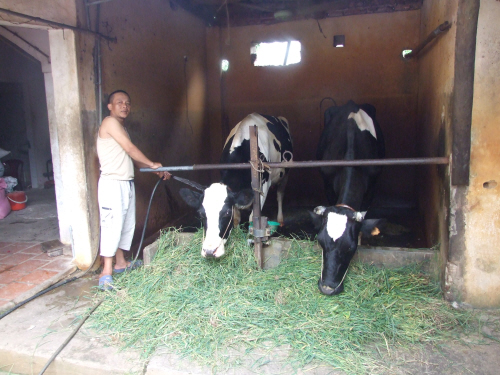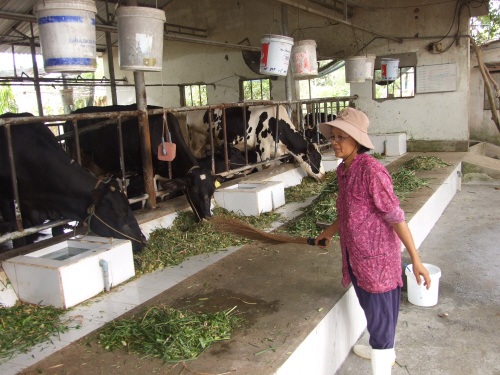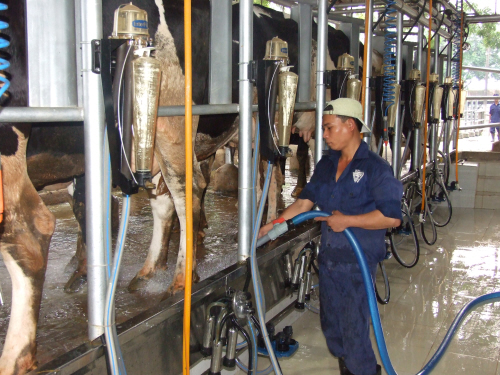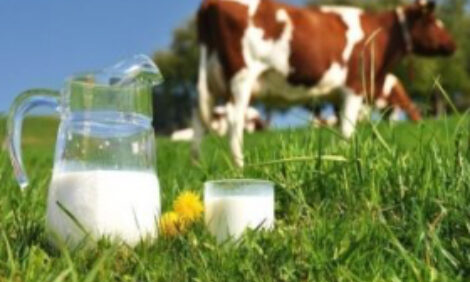



Dairying In Viet Nam
On a recent visit to Viet Nam, Stuart Lumb got the opportunity to visit three dairy units and a processing facility. He writes about them here for TheCattleSite.Typical small unit
One of the fascinating things about working abroad is that you always have to expect the unexpected. I was staying in Hanoi and my guide was Hoang Thi Thuong, who is a dairy expert and is Northern Viet Nam manager for French additives company Olmix.
She told me we were to visit a dairy farm about an hour’s drive outside Hanoi. We duly drove into a small village and parked the car, although I could neither see nor smell any cows. We walked along and then entered a yard at the back of a modest house, where I was introduced to Mr Nguyen Van Duong and his wife. We had the customary cup of tea and I thought that we would shortly be going off outside the village to see Mr Duong’s dairy herd. No such thing!
We walk through the living room, go outside and there under a tiled roof stood his 2 Holstein cows! The cows are permanently housed indoors with sprinklers and roof fans cooling the cows in hot weather. All the feed is brought in by motorbike, the universal means of transport in Viet Nam. Different varities of grasses, King grass and Mulato II are grown in outlying fields, cut by hand and carted in.
A certain amount Mr Duong’s pride and are rent A 40 per cent concentrate (which costs £350/ton) is fed twice / day at the rate of 0.5kg/ kg of milk, with the cows producing 8500 kg milk / lactation.
Price is based on dry matter ,protein and fat, with Mr Duong receiving 22p/ litre for his milk. The government runs a local AI centre with vets carrying out the inseminations ( £2 per straw). Mr Duong takes his milk by motorbike to the village collection centre which has a 700kg bulk tank which is emptied daily, with the milk being transported by tanker 70km to the dairy.

Medium sized dairy unit
Mrs Le has a medium sized dairy farm near to Ho Chi Minh City . She has 73 cows which are a combination of Holstein and local breeds and at the time of my visit there were 38 cows in milk producing 13kg of milk daily giving a daily production of 500kg. Cows are zero grazed, haltered and housed in a wide span open sided building, to allow maximum air circulation.
The cows are hand fed elephant grass which again was cut and carted from the field and put through a chopper. Concentrates are provided in the form of brewer’s grains and manioc along with a compound feed bought from Proconco, one of Viet Nam’s oldest feed millers. Concentrates are fed relative to yield at a rate of 0.4kg per kg of milk produced.
Cows are milked twice daily using a bucket system with the milk being stored in a 17,800litre refrigerated bulk tank, which could hold three day’s production. Mrs Le employs 10 staff and they are all kept busy as feeding and mucking out is all carried by hand plus bucket milking is very labour intensive as well. In the past manure has been spread as fertiliser but it is now used as feedstock for a biogas plant. Dairy farmers in Viet Nam have a choice of selling to one of six companies/ Coops and Mrs Le sells to the Dutch Lady dairy company.
Milk is paid for on the basis of protein, fat and somatic cell count and she is receiving 36p /litre, plus as in Mr Dong’s case the dairy company provides an insemination service. Healthwise mastitis and lameness are problems and using Mistral has proved to be beneficial as well as using traditional remedies. Cows are generally culled after five lactations.

Large dairy unit
Dan Van Luong manages one of the largest dairy farms in Viet Nam, which has 840 cows (400 in milk) plus a further 200 heifers and other young cattle, with the dairy cows getting culled after eight to nine lactations. The farm also has an AI stud of 15 bulls.
The farm is actually a public company and it owns 700ha of land, 400 ha of which is used as grazing during the wet season. The company employs 212 staff which includes three vets, 10 inseminators (who inseminate cows on other farms as well ) plus admin and office staff.
The cows are of mixed breeding , namely Friesian, Brahman and the Australian Droughmaster. Cows are in milk for 300 days, produce 60-70kg / day with lactations averaging 4250kg, giving a herd output in the region of 2.8 tons of milk/day.
The zero grazed cows get fed chopped grass, manioc, brewers grains and concentrates twice / day. Extra concentrates are fed at the rate of 1kg./ 3kg of milk.Milking takes place three times / day through a 20 place herringbone which is fitted with Interpuls measuring equipment.
A plentiful and regular supply of water is essential and this is extracted from a bore and is tested annually for quality.
There is six months storage on the farm for manure and in the past the manure has been spread on the land, but recently a biogas plant has been built and hence the manure now goes to feed the digester. Incidentally there is no grant aid available for bioenergy plants in Viet Nam.

Vinamilk
Vinamilk is the biggest dairy company in Viet Nam.,with 500 employees. The company has its HQ in Ho Chi Minh City and markets 60 [er cent of the nation’s milk, plus butter and yoghurt which is processed through nine plants nationwide.
The average dairy farmer has five to six cows, although one of Vinamilk’s suppliers is a 1000 cow operation. Yields average out at 6000 kg/ year, with these being naturally affected by the high temperatures experienced in April, May and June.
Farmers are paid on total solids and somatic cell count and if this drops below 1 million it triggers a bonus. However, milk powder imports from Australia , New Zealand and the Netherlands have depressed the liquid milk price. Many small farmers have Sindhi(Zebu) x Friesian cows although Vinamilk are importing Holsteins from Australia and New Zealand.
AI is used extensively (95 per cent) to improve yields. Much of the semen is bought from Semex , sourced from 10,000kg/ year indexed bulls and imported from Canada. Semen costs USD 2 per straw although dairy farmers contracted with Vinamilk get their semen and inseminations free as part of their contract.
Vinamilk is improving yields in conjunction with Japanese dairy experts. Allied to good genetics is good nutrition. Viet Nam grows a lot of rice and so feeding rice by products would appear logical, but in fact rice is exported to China and swapped for maize and soyabean meal.
Locally also fast growing grasses such as Buffalo grass, Elephant grass and King grass provide much of the roughage. Attempts to grow alfalfa in the Vietnamese Highlands proved unsuccessful due to low yields and so this leguminous forage crop also has to be imported. Brucellosis is not a problem but as in many other countries sub clinical mastitis is.
Dairy In Viet Nam
Traditionally milk in Viet Nam was only fed to babies and sick people but this is changing as it government policy is promoting milk consumption by all ages of the population. One scheme provides milk to school children that live in rural areas and where family incomes are low.
In the south, the government has set up training centres. Small farmers can get help from government husbandry advisers plus finance to buy equipment. The Dutch government is also funding several training centres as well.
The Vietnamese dairy industry is obviously expanding given the government’s policy to increase the nation’s milk consumption and the quickest way to do this is by building large dairy units, however they will rely heavily on hired labour to produce good results – but “Big is not always Beautiful”.
Having said that it’s clear that small family owned dairy farms where the owner milks the cows and tends them have the incentive to get good yields. These small farms make a big contribution to the nation’s milk production and need to be nutured as a key part of the Vietnamese dairy industry.


